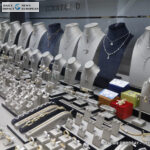Antwerp, the largest port in Belgium after Rotterdam, is the center of the international diamond trade. From the 16th century, thanks to its port which connects India to Europe and America, Antwerp is the 1st stock market in the world. 40% of world trade transits through the port of Antwerp.
The city becomes the largest commercial center in Europe, especially for diamonds. Since then, the city has kept this position as the main diamond center in the world.
Almost every diamond in the world goes through Antwerp once, as do 86% of all rough diamonds, 50% of all cut diamonds in the world and 40% of industrial diamonds. In 2019, 193 million carats, gross and cut, were traded there.
In Antwerp, Chinese, Indians, Arabs, Hindus, Muslims, Christians, Jews … trade together.
In 1492, many Sephardic Jews fled Catholic Spain and Portugal and imported diamonds to Europe. This is why the Antwerp diamond sector still has many Jewish traditions. When selling diamonds, seller and buyer shake hands by saying the words mazal um oevraha, « happiness and blessing ».
During the Spanish Inquisition, Jewish and Protestant merchants fled to Amsterdam and Frankfurt for three centuries and then returned to Antwerp.
The first rough diamonds were imported from India. Their trade dates back to 1447, when a city magistrate published a law punishing the trade in fake precious stones, including diamonds.
Shortly after, a revolutionary process was born, the cutting of faceted diamonds.
By the attention to detail and the quality of the selections, Antwerp quickly acquired a reputation for prestige.
The Antwerp World Diamond Center, established in 1973, represents the Antwerp diamond sector in an official capacity.
It brings together all of the largest diamond mine operators from South Africa, Australia, Russia and Canada and supplies thousands of dealers around the world.
The district, adjacent to Antwerp Central station, has 380 workshops that supply 1,500 cutting and polishing companies.
The sector brings in $ 50 billion a year.
It attracts traders from around the world as well as the general public in search of unique, high-quality diamonds that can be mounted on superb jewelry.
During the French occupation, Napoleon Bonaparte transformed the port into a military port from which he could attack England …
economic history, but also crafts, technology, traditions and creativity.
Since the 60s of the 20th century the Indian community of Antwerp has played an important role in the diamond sector. Indian diamond cutters cut very small stones, which other traders were not interested in, in India. Then the small cut diamonds were sold in Antwerp. He thus created a new niche.
Antwerp is a city where a lot of creative businesses are established; so it’s clearly a breeding ground for creativity. Antwerp stylists are renowned worldwide. The presence of one of the oldest academies of fine arts in Europe contributes to fruitful crossings between creators from various disciplines. For centuries, there have been jewelers transforming stones and precious metals into unique pieces of jewelry.
Your guide will tell you about the great moments, the decline and the comeback of the Antwerp diamond industry in the 19th century.
diamond district: from Central Station to the Diamond Square Mile – you will see the diamond house and pass the jewelers and diamond shops.
Views: 1











Plus d'histoires
Agricultural crisis: farmers bring protests to Paris over EU–Mercosur deal
In Paris, Ukraine and Its Allies Seal Security Guarantees for a Lasting Peace
Arrest of Nicolás Maduro: U.S. Justification, Global Reactions, and Accusations of Double Standards in International Law